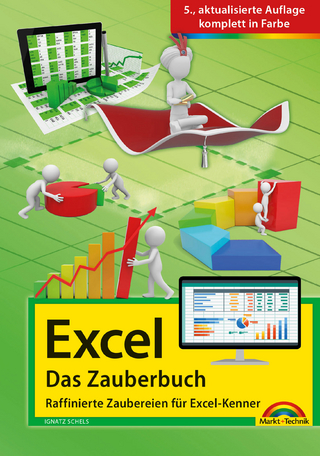
Statistics for People Who (Think They) Hate Statistics
SAGE Publications Inc (Verlag)
978-1-4833-7408-6 (ISBN)
- Titel ist leider vergriffen;
keine Neuauflage - Artikel merken
Based on Neil J. Salkind’s bestselling text, Statistics for People Who (Think They) Hate Statistics, this adapted Excel 2016 version presents an often intimidating and difficult subject in a way that is clear, informative, and personable. Researchers and students uncomfortable with the analysis portion of their work will appreciate the book′s unhurried pace and thorough, friendly presentation. Opening with an introduction to Excel 2016, including functions and formulas, this edition shows students how to install the Excel Data Analysis Tools option to access a host of useful analytical techniques and then walks them through various statistical procedures, beginning with correlations and graphical representation of data and ending with inferential techniques and analysis of variance.
New to the Fourth Edition:
A new chapter 20 dealing with large data sets using Excel functions and pivot tables, and illustrating how certain databases and other categories of functions and formulas can help make the data in big data sets easier to work with and the results more understandable.
New chapter-ending exercises are included and contain a variety of levels of application.
Additional TechTalks have been added to help students master Excel 2016.
A new, chapter-ending Real World Stats feature shows readers how statistics is applied in the everyday world.
Basic maths instruction and practice exercises for those who need to brush up on their math skills are included in the appendix.
Neil J. Salkind received his PhD in human development from the University of Maryland, and after teaching for 35 years at the University of Kansas, he was Professor Emeritus in the Department of Psychology and Research in Education, where he collaborated with colleagues and work with students. His early interests were in the area of children’s cognitive development, and after research in the areas of cognitive style and (what was then known as) hyperactivity, he was a postdoctoral fellow at the University of North Carolina’s Bush Center for Child and Family Policy. His work then changed direction to focus on child and family policy, specifically the impact of alternative forms of public support on various child and family outcomes. He delivered more than 150 professional papers and presentations; written more than 100 trade and textbooks; and is the author of Statistics for People Who (Think They) Hate Statistics (SAGE), Theories of Human Development (SAGE), and Exploring Research (Prentice Hall). He has edited several encyclopedias, including the Encyclopedia of Human Development, the Encyclopedia of Measurement and Statistics, and the Encyclopedia of Research Design. He was editor of Child Development Abstracts and Bibliography for 13 years. He lived in Lawrence, Kansas, where he liked to read, swim with the River City Sharks, work as the proprietor and sole employee of big boy press, bake brownies (see www.statisticsforpeople.com for the recipe), and poke around old Volvos and old houses.
Part I: Yippee! I’m in Statistics
Chapter 1: Statistics or Sadistics? It’s Up to You
Why Statistics?
A Five-Minute History of Statistics
Statistics: What It Is (and Isn’t)
Tooling Around With the Analysis ToolPak
What Am I Doing in a Statistics Class?
Ten Ways to Use This Book (and Learn Statistics at the Same Time!)
About Those Icons
Key to Difficulty Icons
Key to “How Much Excel” Icons
Little Chapter 1a. All You Need to Know About Formulas and Functions
What’s a Formula?
What’s a Function?
Little Chapter 1b. All You Need to Know About Using the Amazing Analysis ToolPak
A Look at the Analysis ToolPak
Don’t Have It?
Little Chapter 1c. Mac Lovers Rejoice! StatPlus: The Mac Alternative to the Analysis ToolPak
Little Chapter 1c. For Mac Lovers Who are Still using Version 2011: Rejoice!! And, for Mac Lovers Who are new to Version 2016, Rejoice More!!!
Part II: Sigma Freud and Descriptive Statistics
Chapter 2: Computing and Understanding Averages: Means to an End
Computing the Mean
Computing a Weighted Mean
Computing the Median
Computing the Mode
Using the Amazing Analysis ToolPak to Compute Descriptive Statistics
When to Use What
Chapter 3: Vive la Différence: Understanding Variability
Why Understanding Variability Is Important
Computing the Range
Computing the Standard Deviation
Computing the Variance
And Now... Using Excel’s VAR.S Function
The Standard Deviation Versus the Variance
Using the Amazing Analysis ToolPak (Again!)
Chapter 4: A Picture Really Is Worth a Thousand Words
Why Illustrate Data?
Ten Ways to a Great Figure (Eat Less and Exercise More?)
First Things First: Creating a Frequency Distribution
The Plot Thickens: Creating a Histogram
Fat and Skinny Frequency Distributions
Excellent Charts
Excellent Charts Part Deux: Making Charts Pretty
Other Cool Charts
Chapter 5: Ice Cream and Crime: Computing Correlation Coefficients
What Are Correlations All About?
Computing a Simple Correlation Coefficient
More Excel—Bunches of Correlations à la Excel
Using the Amazing Analysis ToolPak to Compute Correlations
Understanding What the Correlation Coefficient Means
As More Ice Cream Is Eaten... the Crime Rate Goes Up (or Association Versus Causality)
Other Cool Correlations
Chapter 6: Just the Truth: An Introduction to Understanding Reliability and Validity
An Introduction to Reliability and Validity
All About Measurement Scales
Reliability—Doing It Again Until You Get It Right
Validity—Whoa! What Is the Truth?
A Last, Friendly Word
Validity and Reliability: Really Close Cousins
Part III: Taking Chances for Fun and Profit
Chapter 7: Hypotheticals and You: Testing Your Questions
So You Want to Be a Scientist...
The Null Hypothesis
The Research Hypothesis
What Makes a Good Hypothesis?
Chapter 8: Are Your Curves Normal? Probability and Why It Counts
Why Probability?
The Normal Curve (aka the Bell-Shaped Curve)
Our Favorite Standard Score: The z Score
Part IV: Significantly Different: Using Inferential Statistics
Chapter 9: Significantly Significant: What It Means for You and Me
The Concept of Significance
Significance Versus Meaningfulness
An Introduction to Inferential Statistics
An Introduction to Tests of Significance
An Introduction to Tests of Significance
Chapter 10: Only the Lonely: The One-Sample Z-Test
Introduction to the One-Sample Z-Test
Computing the Test Statistic
Using the Excel Z.TEST Function to Compute the z Value
Chapter 11: t(ea) for Two: Tests Between the Means of Different Groups
Introduction to the t-Test for Independent Samples
Computing the Test Statistic
Using the Amazing Analysis ToolPak to Compute the t Value
Special Effects: Are Those Differences for Real?
Chapter 12: t(ea) for Two (Again): Tests Between the Means of Related Groups
Introduction to the t-Test for Dependent Samples
Computing the Test Statistic
Using the Amazing Analysis ToolPak to Compute the t Value
Chapter 13: Two Groups Too Many? Try Analysis of Variance
Introduction to Analysis of Variance
Computing the F-Test Statistic
Using the Amazing Analysis ToolPak to Compute the F Value
Chapter 14: Two Too Many Factors: Factorial Analysis of Variance—A Brief Introduction
Introduction to Factorial Analysis of Variance
The Main Event: Main Effects in Factorial ANOVA
Even More Interesting: Interaction Effects
Computing the ANOVA F Statistic Using the Amazing Analysis ToolPak
Chapter 15: Cousins or Just Good Friends? Testing Relationships Using the Correlation Coefficient
Introduction to Testing the Correlation Coefficient
Computing the Test Statistic
Chapter 16: Predicting Who’ll Win the Super Bowl: Using Linear Regression
What Is Prediction All About?
The Logic of Prediction
Drawing the World’s Best Line (for Your Data)
Computing the Regression Equation Using the Amazing Analysis ToolPak
How Good Is Our Prediction?
The More Predictors, the Better? Maybe
Chapter 17: What to Do When You’re Not Normal: Chi-Square and Some Other Nonparametric Tests
Introduction to Nonparametric Statistics
Introduction to One-Sample Chi-Square
Computing the Chi-Square Test Statistic
Other Nonparametric Tests You Should Know About
Chapter 18: Some Other (Important) Statistical Procedures You Should Know About
Post Hoc Comparisons
Multivariate Analysis of Variance
Repeated Measures Analysis of Variance
Analysis of Covariance
Multiple Regression
Logistic Regression
Factor Analysis
Data Mining
Path Analysis
Structural Equation Modeling
Chapter 19: A Statistical Software Sampler
Selecting the Perfect Statistics Software
What’s Out There
Chapter 20: (Mini) Data Mining: A Introduction to Getting The Most Out Of Your BIG Data
Part V: Ten Things You’ll Want to Know and Remember
Chapter 21: The Ten (or More) Best (and Most Fun) Internet Sites for Statistics Stuff
How About Studying Statistics in Stockholm?
Calculators Galore!
Who’s Who and What’s Happened
It’s All Here
HyperStat
Data? You Want Data?
More and More Resources
Plain, But Fun
Online Statistical Teaching Materials
And, of Course, YouTube...
Chapter 22: The Ten Commandments of Data Collection
Appendix A: Excel-erate Your Learning: All You Need to Know About Excel
Appendix B: Tables
Appendix C: Data Sets
Appendix D: Answers to Practice Questions
Appendix E: Math – Just the Basics
Appendix F: The Reward: The Brownie Recipe
| Erscheinungsdatum | 22.03.2016 |
|---|---|
| Verlagsort | Thousand Oaks |
| Sprache | englisch |
| Maße | 177 x 254 mm |
| Gewicht | 810 g |
| Themenwelt | Informatik ► Office Programme ► Excel |
| Mathematik / Informatik ► Mathematik ► Statistik | |
| Sozialwissenschaften ► Soziologie ► Allgemeines / Lexika | |
| ISBN-10 | 1-4833-7408-4 / 1483374084 |
| ISBN-13 | 978-1-4833-7408-6 / 9781483374086 |
| Zustand | Neuware |
| Informationen gemäß Produktsicherheitsverordnung (GPSR) | |
| Haben Sie eine Frage zum Produkt? |
aus dem Bereich


